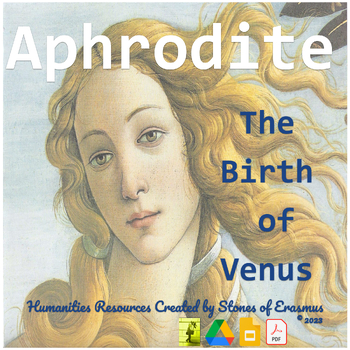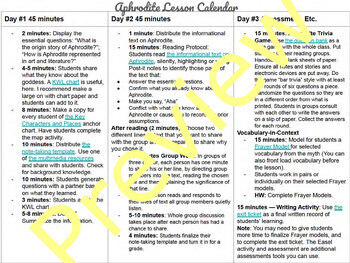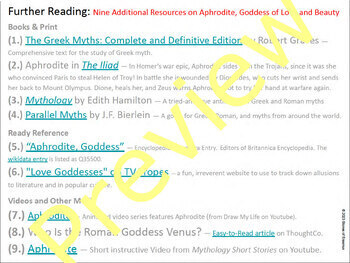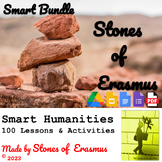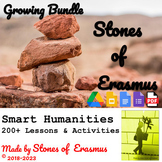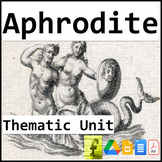Aphrodite's Birth: Grade 9-11 Greek/Roman Mythology Unit ELA
- Google Drive™ folder
- Easel Activity
- Easel Assessment

Also included in
- Expand your offerings and broaden the scope of a humanities curriculum for middle and high school with☝100 educational units! Entirely print + digital — Adobe Acrobat and Google Workspace power each download. Extra addition: Includes free-to-use out-of-the-box Easel Activities and Easel AssessmentsPrice $350.00Original Price $470.10Save $120.10
- Everything related to broadening the scope of a humanities curriculum for middle and high school is included in this growing bundle.☝211 and growing educational units! Entirely print + digital — Adobe Acrobat and Google Apps power each download. Extra addition: Includes free-to-use out-of-the-box EaPrice $590.00Original Price $906.85Save $316.85
- Teach the Twelve Gods and Goddesses of Olympus that make up the top hierarchy of the Greek and Roman pantheon. Note: This Educational Digital Download is Available as a Print PDF, Google Apps, or Easel.The unit bundle contains the following:Each lesson comes with a three-day lesson calendar, readingPrice $38.00Original Price $57.25Save $19.25
- Dive into the intriguing world of Aphrodite, a figure not limited to her role as the goddess of love. Our thematic unit uncovers her rich mythology, offering students an engaging journey through various myths and legends. Explore the multifaceted narratives surrounding this mesmerizing yet formidablPrice $31.00Original Price $46.50Save $15.50
- Dive into the enchanting realm of Greek mythology with Bernard Evslin's 1966 masterpiece, 'Heroes, Gods and Monsters of the Greek Myths.' This resource is far from your typical, monotonous worksheets filled with dull questions. Instead, it presents a novel approach to exploring mythology in middle aPrice $88.00Original Price $135.00Save $47.00
Description
Who is Aphrodite? She is the goddess of love and beauty — born out of seafoam near the Mediterranean island of Cyprus. However, Homer recounts she was born of Dione, a Titaness, and Zeus. She is one of the original twelve Olympian deities, and her cult extends beyond Greek religion and myth to literature, art, and more. This lesson includes a three-day plan, including art and literature connections, a question bank, and a group reading activity. Use the further reading guide and included links to supplement this lesson with myth-related books, websites, and more.
This Resource Includes the Following Features:
- Available as a PDF, Google Workspace, and as an Easel Activity and Assessment
- 1 Teacher Three-day Lesson Calendar (with Teacher's Notes)
- 1 Key Characters and Places Anchor Chart
- Orient your learners by identifying the key characters and the geographical location that situates Aphrodite's birth near Cyprus's shores in the Mediterranean Sea.
- Informational Text: Aphrodite: God of Love and Beauty
- Six Pages of text on the cult of Aphrodite.
- Comparative mythology studies on the Mesopotamian goddess Ishtar.
- Includes artwork from engravings, prints, and paintings, including Sandro Botticelli's piece "The Birth of Venus" and the 1st Century B.C.E. Roman sculpture "The Venus Medici).
- Includes a Student-Friendly Reading Protocol.
- 12-Count Question Bank
- Check for understanding with a quick and adaptable question bank.
- Includes a Custom Note-taking template to ensure student accountability!
- Frayer Model Vocabulary Cards (with one student sample)
- Frayer models are a way to get kids to think about vocabulary visually in a four-section square —- A square for meaning, one for examples, another for non-examples, and a sketch. It is amazing to see the work they produce. A great way to decorate your classroom to showcase your kids' vocabulary-in-text understanding. The cards contain terms, geography, challenging words (as well as contextual entries that fit the story).
- 2 Half-Sheet Exit Tickets
- Exit tickets are a way to get data about your students' understanding of the lesson right before the class is finished. Collect these exit tickets and quickly see what your students have learned. I also provide two different tickets to offer academic choices for students.
- 1 Further Reading List
- Don't disregard this further reading list if you think it is merely a bibliography. Share the list with your students or have them do projects based on the available research. Assign different sources to students and organize presentations where learning can go deeper into the story.
- Answer Keys for all student-facing documents
- Teachers always ask for answer keys for my products, so I gave you plenty of guidance on what to expect from students in their written and oral responses.
I created this resource with high school students in mind. It is designed for an English Language Arts Mythology unit —
- Encourage students to talk about the concept of beauty, human sexuality, representations of women in art, and more!
- Conduct a comparative reading of Aphrodite's ancient origins in the Mediterranean and Middle Eastern World!
- Compare and contrast characteristics of the gods and goddesses in World Literature and Mythology.
- Use this resource as a stand-alone lesson or pair it with a larger unit on early Greek myths, primordial stories, Percy Jackson and the Lightning Thief, Robert Graves's Greek Myths, or Edith Hamilton's Mythology.
- For Valentine's Day or any day to celebrate love.
Know that this educational digital download supplements a unit on Greek Mythology. The lesson also includes links to full-text primary resources online.
For resources similar to this one, see:
☆ Zeus and Metis & The Birth of Athena
☆ See more lessons included in the Middle and High School Mythology Series
☆ And the popular Plato's Cave lesson!
Special thanks to the New York Public Library Digital Collections for making a tremendous amount of public domain material available to the general public. Thank you! Navigate your web browser to my website, Stones of Erasmus, to follow me on my journey. © 2023 stonesoferasmus.com

